Influences on Fashion in the 1920s

Canadian Home Periodical, 1920

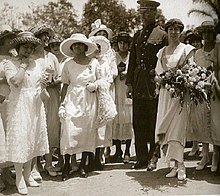
Brazilian women salute Belgian monarchs on their inflow in Belo Horizonte, Brazil. 2 October 1920
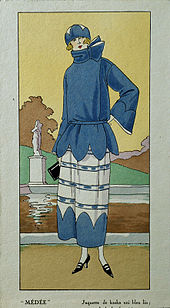
A cartoon picturing French women'due south fashion, c.1921

Lawn tennis histrion, Australia 1924
Western fashion in the 1920s underwent a modernization. For women, fashion had continued to change away from the extravagant and restrictive styles of the Victorian and Edwardian periods, and towards looser clothing which revealed more of the arms and legs, that had begun at least a decade prior with the rising of hemlines to the ankle and the motion from the S-bend corset to the columnar silhouette of the 1910s. Men also began to wearable less formal daily attire and athletic clothing or 'Sportswear' became a role of mainstream fashion for the first time. The 1920s are characterized by 2 singled-out periods of way: in the early on part of the decade, change was slower, and there was more reluctance to wear the new, revealing pop styles. From 1925, the public more passionately embraced the styles now typically associated with the Roaring Twenties. These styles connected to narrate style until the worldwide depression worsened in 1931.
Overview [edit]
After World War I, the Us entered a prosperous era and, equally a result of its function in the war, came out onto the earth stage. Social community and morals were relaxed in the optimism brought on by the end of the war and the booming of the stock market. Women were entering the workforce in tape numbers. In the Usa, at that place was the enactment of the 18th Amendment, or as many know it, Prohibition, in 1920. Prohibition stated that information technology would be illegal to sell and eat booze. This lasted until 1933, so information technology was a constant for the whole 1920s era. They instilled this "noble experiment" to reduce crime and corruption, solve social problems, reduce the tax burden created past prisons and poorhouses, and improve health and hygiene. The nationwide prohibition on alcohol was ignored past many resulting in speakeasies. Some other important amendment in the United States was the 19th Subpoena, which gave women the right to vote. At that place was a revolution in nigh every sphere of human activity. Fashion was no exception; women entered the workforce and earned the correct to vote, and they felt liberated. Fashion trends became more accessible, masculine, and practical, creating the emergence of "The New Woman". Flappers was a popular name given to women of this fourth dimension because of what they wore. The constrictive corset, an essential undergarment to make the waist thinner, became a thing of the past.[1]
The development of new fabrics and new means of fastening clothing affected fashions of the 1920s. Natural fabrics such equally cotton and wool were the abundant fabrics of the decade. Silk was highly desired for its luxurious qualities, merely the limited supply fabricated it expensive. In the belatedly 19th century, "artificial silk" was offset made in France, from a solution of cellulose. After being patented in the United states of america, the get-go American plant began production of this new fabric, in 1910. This fiber became known as rayon. Rayon stockings became popular in the decade as a substitute for silk stockings. Rayon was also used in some undergarments. Many garments before the 1920s were fastened with buttons and lacing. However, during this decade, the development of metallic hooks and eyes meant that there were easier means of fastening clothing. Hooks and eyes, buttons, zippers, and snaps were all used to fasten article of clothing.
Vastly improved production methods enabled manufacturers to easily produce wear affordable past working families. The boilerplate person'due south fashion sense became more than sophisticated. Meanwhile, working-form women looked for modern forms of dress equally they transitioned from rural to urban careers. Taking their cue from wealthier women, working women began wearing less expensive variations on the day suit, adopting a more modern look that seemed to suit their new, technologically focused careers as typists and telephone operators.[2]
Although uncomplicated lines and minimal adornment reigned on the runways, the 1920s were not free of luxury. Expensive fabrics, including silk, velvet, and satin were favored by high-end designers, while department stores carried less expensive variations on those designs made of newly bachelor constructed fabrics. The utilize of mannequins became widespread during the 1920s and served every bit a way to testify shoppers how to combine and accessorize the new fashions. The modern manner bike, established in the 1920s, still dominates the industry today. Designers favored separates in new fabrics similar bailiwick of jersey that could exist mixed and matched for work and mod, breezy, un-chaperoned social activities like attention films or the theater and car rides.[ii]
Women's wear [edit]
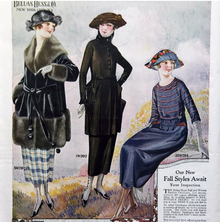
Bellas Hess and Visitor advertise item, 1920

By early on 1920s, most women not dared to bob their hair, so they pinned upwards to look shorter. Mlle Cayet, Queen of Parisian Carnival, 1922

Betwixt 1922 and 1923, the waistline dropped to the hips. The 1920s classic tubular fashion was born. Parisian fashion house Madeleine-et-Madeleine design, Jan, 1922.
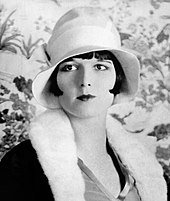
Paris fix the way trends for Europe and North America.[3] The fashion for women was all near letting loose. Women wore dresses all day, every day. Day dresses had a drop waist, which was a belt effectually the low waist or hip and a brim that hung anywhere from the ankle on up to the knee, never to a higher place. Daywear had sleeves (long to mid-bicep) and a brim that was straight, pleated, hank hem, or tiered. Hair was often bobbed, giving a boyish look.[4]
Clothing fashions changed with women's changing roles in lodge, peculiarly with the idea of new mode. Although society matrons of a sure age continued to wear conservative dresses, the sportswear worn past forward-looking and younger women became the greatest change in post-war fashion. The tubular dresses of the 'teens had evolved into a like silhouette that now sported shorter skirts with pleats, gathers, or slits to permit motility. The most memorable fashion tendency of the Roaring Twenties was undoubtedly "the flapper" look. The flapper clothes was functional and flattened the bust line rather than accentuating information technology.[one]
The straight-line chemise topped by the shut-fitting cloche hat became the compatible of the day. Women "bobbed", or cut, their hair brusk to fit nether the popular hats, a radical move in the outset, but standard past the end of the decade. Depression-waisted dresses with fullness at the hemline allowed women to literally kick upward their heels in new dances similar the Charleston. In 1925, "shift" type dresses with no waistline emerged. At the finish of the decade, dresses were being worn with straight bodices and collars. Tucks at the bottom of the bodices were pop, also as knife-pleated skirts with a hem approximately ane inch below the knee.[5]
In the world of fine art, style was being influenced heavily by art movements such as surrealism. Elsa Schiaparelli is one key Italian designer of this decade who was heavily influenced by the "across the real" art and incorporated it into her designs.
Proper attire for women was enforced for morning, afternoon, and evening activities. In the early on part of the decade, wealthy women were notwithstanding expected to change from a morning to an afternoon dress. These afternoon or "tea gowns" were less form-plumbing fixtures than evening gowns, featured long, flowing sleeves, and were adorned with sashes, bows, or artificial flowers at the waist. For evening clothing the term "cocktail dress" was invented in France for American clientele. With the "New Woman" also came the "Drinking Woman". The cocktail dress was styled with a matching hat, gloves, and shoes. What was so unique about the cocktail dress was that it could be worn not just at cocktail hours (6 and 8pm), simply by manipulating and styling the accessories correctly could be worn appropriately for any upshot from 3 pm to the late evening. Evening gowns were typically slightly longer than tea gowns, in satin or velvet, and embellished with chaplet, rhinestones, or fringe.[2]
Accessories [edit]
Ane of the key accessories in the 20s was the Cloche chapeau. "In 1926 Vogue stated 'The Bob Rules', just nine years afterward the influential dancer, Irene Castle, cut her hair. This trending topic inspired a 1920 curt story by F. Scott Fitzgerald, called Bernice Bobs Her Hair, and many editorials in Faddy throughout the decade."[half dozen] The bob hairstyle matched perfectly with the loose and direct silhouette of the times. During this era Vogue gave credit to this new cut for the immense success of the hat business organization. New haircuts meant new styled hats, therefore at that place was a new craze for hats. The cloche chapeau and the bob were basically made for each other.
Jewelry was less conspicuous.[7] Jewelry was much less elaborate, and began using 'romantic', more natural shapes. The Art Nouveau movement of 1890-1910 inspired most of the natural forms and geometric shapes of the jewelry during the 1920s. "Aesthetic clean lines were inspired by designs plant in industrial machines. A cardinal influence of this modernism was the influential Bauhaus movement, with its philosophy of class post-obit function. Contrasting textures and colour were also in style. Examples of changing tastes in design were the utilize of diamonds beingness prepare confronting onyx or trans lucid vitrines and amethysts juxtaposed against opaque coral and jade."[eight] Even though geometric shapes and cleaner shaped jewelry were now a trend, one of the central pieces was the long rope pearl necklace. The long rope pearl necklace was a signature imitation piece that was sold everywhere at the time. It was inexpensive and basic in a adult female's wardrobe. "Although buffeted by cycles of nail, depression and war, jewelry design between the 1920s and 1950s continued to exist both innovative and glamorous. Precipitous, geometric patterns historic the automobile age, while exotic creations inspired by the Near and Far E hinted that jewelry fashions were truly international."[9]
Shoes were finally visible during the 1920s. Before, long garments covered upwards shoes, and then they weren't an important part of women'due south way. At present, shoes were seen past everyone and played an important part during the 1920s. Women had all kinds of shoes for all kinds of events. Everything from business firm shoes, walking shoes, dancing shoes, sporting shoes, to swimming shoes. The shoe industry became an important industry that transformed the way nosotros purchase shoes today. Shoes were made in standard sizes perfect to lodge from mode catalogs to the near boutique. In the showtime of the 1920s, Mary Janes were still popular from previous era, although they paved the mode for the invention of many other shoes. The T-strap heel was a variation of the Mary Jane, having the same base with the addition of a strap going around the heel and down to the summit of the shoe that looked like a T. Also, "The bar shoe which attached with a strap and a single button became pop during the 1920s. It was worn with the new brusque skirts and was applied for their vigorous mode of dancing."[10]
The influence of jazz [edit]
"The Jazz Age", a term coined by F. Scott Fitzgerald, was a phrase used to stand for the mass popularity of jazz music during the 1920s.[11] Both jazz music and dance marked the transition from the archaic societal values of the Victorian era to the inflow of a new youthful mod society. Jazz gained much of its popularity due to its perceived exoticism, from its Afro-American roots to its melodic and soulful rhythm. The music itself had quite an alluring effect on the new youthful society and was considered to exist the pulse of the 1920s due to its spontaneity. With new music emerged new dancing. Jazz dances, such every bit the Charleston, replaced the slow waltz. Paul Whitman popularized jazz dance. In fact, jazz music and dance are responsible for the origin of the iconic term "flapper", a group of new socially unconventional ladies. When dancers did the Charleston, the fast motility of the feet and swaying of the artillery resembled the flapping movements of a bird.[eleven] Jazz music sparked the demand to dance, and dance sparked the need for new clothing, peculiarly for women to easily trip the light fantastic toe without being constricted.
Dances such as the Charleston and the Black Bottom in detail created a need for a revival in women'south evening wear due to the dynamic and lively manner of these jazz dances. Dress and skirt hems became shorter in club to let the trunk to motility more easily. In addition, decorative embellishments on dresses such as fringe threads swung and jingled in sync with the movement of the body. Lastly, the use of glossy and ornate textiles mirrored light to the tempo of jazz music and trip the light fantastic toe.[12] Jazz music and its perceived exotic nature had both a flamboyant influence on manner while keeping both course and function in mind.
Jazz and its influence on mode reached even further, with both jazz and dance motifs making their mode onto textiles. These new textile designs included uneven repetitions and linear geometric patterns. Many cloth patterns produced in the United States also incorporated images of both jazz bands and people dancing to jazz.[13] The print Rhapsody shows a textile produced in 1925 representing a jazz band in a polka-dot like manner.[xiv] Not only did textiles have motifs of people dancing and playing jazz music, they included designs that were based on the overall rhythmic feel and audio of jazz music and dance.
The boyish effigy [edit]
Undergarments began to transform afterwards Earth War I to conform to the ideals of a flatter chest and more than boyish figure. The female effigy was liberated from the restrictive corset, and newly popular the boyish look was achieved through the apply of bust bodices. Some of the new pieces included chemises, thin camisoles, and cami-knickers, later on shortened to panties or knickers. These were primarily made from rayon and came in soft, light colors in society to be worn under semi-transparent fabrics.[15] Immature flappers took to these styles of underwear due to the power to motion more freely and the increased comfort when dancing to the high tempo jazz music. During the mid-1920s, all-in-one lingerie became popular.
For the start time in centuries, women's legs were seen with hemlines ascension to the knee and dresses condign more fitted. A more masculine look became popular, including flattened breasts and hips, short hairstyles such as the bob cut, Eton ingather, and the Marcel wave. The fashion was seen as expressing a maverick and progressive outlook.
One of the showtime women to wear trousers, cutting her hair brusque, and reject the corset was Coco Chanel. Probably the most influential woman in way of the 20th century, Chanel did much to farther the emancipation and freedom of women's fashion.
Jean Patou, a new designer on the French scene, began making 2-piece sweater and brim outfits in luxurious wool jersey and had an instant hit for his morning dresses and sports suits. American women embraced the clothes of the designer equally perfect for their increasingly active lifestyles.
By the finish of the 1920s, Elsa Schiaparelli stepped onto the stage to stand for a younger generation. She combined the idea of archetype pattern from the Greeks and Romans with the modernistic imperative for freedom of movement. Schiaparelli wrote that the aboriginal Greeks "gave to their goddesses... the quiet of perfection and the fabulous appearance of freedom." Her own interpretation produced evening gowns of elegant simplicity. Departing from the chemise, her dress returned to an awareness of the trunk beneath the evening gown.
- Style gallery 1920–25
-

Summer sport suit, 1920.
-

Actress Elaine Hammerstein, 1921. The forehead was commonly covered in the 1920s, here by a lid reaching to the eyebrows.
-

Rolled stockings, 1922.
-

Robe de way, Lanvin, 1922.
-

Dress with a dropped waist and width at the hips, 1923.
-
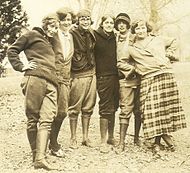
Teenage girls in Minnesota wearing breeches and riding boots with men's neckties, 1924.
-

Past 1925, skirts concluded but below the knee. Tunic-tops and sweaters reaching to the hips were popular.
- Way gallery 1926–29
-

Extra Aileen Pringle wearing a cloche hat and boldly patterned coat, 1926.
-

Actress Alice Joyce in a straight apparel with a sheer beaded overdress, 1926.
-

A painting showing the mid-decade silhouette at its simplest: languid pose, bobbed hair, knee-length dress with dropped waist, 1926.
-

Woman with Umbrella, Ipolit Strâmbu, 1927. Designers used multiple hemlines (here, tiers of ruffles) to acquaint the eye to longer skirts. This apparel foreshadows the higher waist and feminine look that spread to everyday fashion by the early 1930s.
-

Woman hiding a hip flask tucked in her garter belt during Prohibition, tardily 1920s.
-

May 1928, belly and curves. After many years of a "stovepipe" silhouette, "natural" curves were beginning to reappear.[16]
-

Knee joint-length, pleated skirts and dropped waists were even so popular as everyday clothes in 1929, though Paris designers were already showing longer skirts and higher waistlines.
-
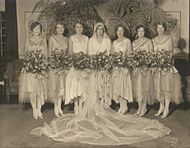
Bridesmaids gowns of 1929 have knee-length underskirts and longer, sheer over skirts, foreshadowing the trend toward longer skirts. Minnesota, 1929.
Menswear [edit]
In menswear, there were two distinct periods in the 1920s. Throughout the decade, men wore short suit jackets, the one-time long jackets beingness used merely for formal occasions. In the early 1920s, men's fashion was characterized by extremely loftier-waisted jackets, often worn with belts. Lapels on conform jackets were not very wide equally they tended to be buttoned up high. This manner of jacket seems to take been profoundly influenced by the uniforms worn past the military during the Commencement Globe War. Trousers were relatively narrow and straight and they were worn rather short and so that a man's socks often showed. Trousers likewise began to be worn cuffed at the bottom at this fourth dimension.
By 1925, wider trousers commonly known as Oxford numberless came into fashion, while suit jackets returned to a normal waist and lapels became wider and were oft worn peaked. Loose-fitting sleeves without a taper also began to be worn during this period. During the late 1920s, double-breasted vests, often worn with a single-breasted jacket, besides became quite fashionable. During the 1920s, men had a variety of sport clothes available to them, including sweaters and brusk trousers (commonly known in American English equally knickers). For formal occasions in the daytime, a morning arrange was usually worn. For evening wear men preferred the short tuxedo to the tail coat, which was now seen as rather old-fashioned and snobby.
Men's mode besides became less regimented and formal. Men favored short jackets with two or iii buttons rather than jackets with long tailcoats likewise as pinstriped suits. Casual-wear for men ofttimes included knickers, short pants that came to the knee.[1] The most formal men'south conform consisted of a black or midnight-blue worsted swallow-tailed coat trimmed with satin, and a pair of matching trousers, trimmed down the sides with wide braid or satin ribbon.[17] A white bow necktie, black silk top hat, white gloves, patent leather Oxford shoes, a white silk handkerchief, and a white blossom boutonnière completed the outfit. The tuxedo vest could be blackness or white, but, unlike the obligatory full-dress white tie, tuxedos ties were always black. Men usually completed their tuxedo outfit with all the same accessories as the full-dress suit, except that instead of top hats they would wear dark, dome-shaped hats called bowlers. Just like women, men had certain attire that was worn for certain events. Tuxedos were appropriate attire at the theater, pocket-size dinner parties, entertaining in the domicile, and dining in a eating house. During the early 1920s, nearly men's apparel shirts had, instead of a neckband, a narrow neckband with a buttonhole in both the front end and back. By the mid-1920s, nevertheless, many men preferred shirts with attached collars, which were softer and more comfortable than rigid, detachable collars.[17]
- Men'due south hats
Men'south hats were unremarkably worn depending on their class, with upper grade citizens normally wearing elevation hats or a homburg lid. Middle-class men wore either a fedora, bowler hat, or a trilby hat. During the summer months, a straw boater was popular for upper grade and middle-class men. Working-grade men wore a standard newsboy cap or a flat cap.
- Style gallery
-

Publisher Edward Beale McLean wearing a three-piece striped suit with a spread-collar shirt, 1924.
-
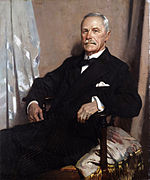
-
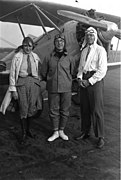
German aviators, 1 a prince, 1929.
Style influences and trends [edit]
During the 1920s, the notion of keeping up with mode trends and expressing oneself through material goods seized middle-grade Americans as never before. Purchasing new clothes, new appliances, new automobiles, new anything indicated one's level of prosperity. Being considered old-fashioned, out-of-date, or—worse yet—unable to afford stylish new products was a fate many Americans went to groovy lengths to avoid.[17]
For women, face up, effigy, coiffure, posture, and training had become important fashion factors in addition to article of clothing. In detail, cosmetics became a major industry. Women did not feel ashamed for caring nigh their advent and information technology was a annunciation of self-worth and vanity, hence why they no longer wanted to achieve a natural look. For evenings and events, the popular look was a smoky heart with long lashes, rosy cheeks and a assuming lip. To emphasize the eyes, Kohl eyeliner became popular, and was the first time they knew annihilation of eyeliner (information almost Egyptian fashion was not discovered until later on in the 1920s). Women also started wearing foundation and using pressed powder. Besides, with the invention of the swivel lipstick, lipstick was on the rise with bright colors and they applied their lipstick to achieve a cupid'southward bow and "bee stung" await.
Glamour was at present an important fashion trend due to the influence of the motion picture industry and the famous female movie stars. Way, at many social levels, was heavily influenced by the newly created, larger-than-life movie stars. For the first time in history, mode influences and trends were coming from more than one source.[five] Not dissimilar today, women and men of the 1920s looked to moving-picture show stars as their fashion icons. Women and men wanted to emulate the styles of Hollywood stars such as Louise Brooks, Greta Garbo, Rudolph Valentino, and Clark Gable.[ane]
Work clothes [edit]
For working class women in the 1920s, tailored suits with a straight, curve less cut were popular. Throughout the decade, the lengths of skirts were rise to the knee and then to the ankle various times affecting the skirt fashion of tailored suits.[eighteen] Rayon, an bogus silk material, was almost common for working-course women clothing.[19]
For working-class men in the 1920s, suits were popular. Depending on the job championship and season of the year, the adapt would change.[xx] These would have featured high lapels and were oft made of thick wool cloth before the appearance of key heating.[21]
Children's manner [edit]
Mode for children started to become more than stylish and comfy in the 1920s. Dress were made out of cotton wool and wool rather than silk, lace, and velvet. Clothes were also made more than sturdy in gild to withstand play. During previous decades, many layers were worn; however, during the 1920s, minimal layers became the new standard.[22]
For girls, clothing became looser and shorter. Dresses and skirts were now knee length and loose plumbing fixtures. Shoes were also made out of canvas, making them lighter and easier to article of clothing.[22]
For boys, knee-length trousers were worn all year long and would be accompanied past ankle socks and canvas shoes. Pullovers and cardigans were also worn when the atmospheric condition became cooler.[22]
-

Roller-skater, Mississippi, 1921.
-

Children's fashion, Federal republic of germany, 1925.
See also [edit]
- Cosmetics in the 1920s
- Roaring Twenties
- Flapper
- Interwar period
Notes [edit]
- ^ a b c d Marsha Due west. Way Trends of the Twenties. July 1, 2008.
- ^ a b c Fashion in the 1920s (Overview). Popular Culture Universe: Icons, Idols, Ideas. ABC-CLIO, 2011. Retrieved Dec 24, 2012.
- ^ Mary Louise Roberts, "Samson and Delilah revisited: the politics of women's fashion in 1920s French republic". American Historical Review 98.3 (1993): 657-684.
- ^ Steven Zdatny, "The Adolescent Wait and the Liberated Woman: The Politics and Aesthetics of Women's Hairstyles." Fashion Theory 1.4 (1997): 367-397.
- ^ a b Carol Nolan. "Ladies Fashions of the 1920s". Retrieved December 24, 2012.
- ^ "Vogue past the Decade". Vogue.
- ^ Simon Bliss, "'L'intelligence de la parure': Notes on Jewelry Wearing in the 1920s." Fashion Theory 20.ane (2016): five-26.
- ^ "1920s Jewellery Style and Inspiration". Winterson.
- ^ "A history of jewellery". Victoria and Albert.
- ^ Sancaktar, Asli. "An Analysis of Shoe Within the Context of Social History of Manner" (PDF).
- ^ a b Langley, Susan (2005-09-28). Roaring '20s Fashions: Jazz. Atglen, PA: Schiffer Publishing. ISBN9780764323195.
- ^ Hannel, Susan L. (2005). "iv The Influence of American Jazz on Style". Twentieth-Century American Fashion. Wearing apparel, Body, Culture. doi:10.2752/9781847882837/tcaf0008. ISBN9781847882837.
- ^ Hannel, Susan L. (2002). The Africana craze in the Jazz Age : a comparison of French and American mode, 1920-1940 / (Thesis). [ permanent dead link ]
- ^ "Textile, Americana Print: Rhapsody, 1925". Cooper Hewitt, Smithsonian Design Museum . Retrieved 2017-x-09 .
- ^ Thornton, Zita (2011). Fashion for a Jazz Age. Chicago, IL: Lightner Publishing Corp. p. 39.
- ^ "Back to Beauty". The Spirella Magazine. May 1928. p. 72.
- ^ a b c Bob Batchelor. "Manner in the 1920s". American Pop: Popular Culture Decade by Decade, Volume 1: 1900–1929. Greenwood Press, 2009. pp. 292-302.
- ^ Vermont, Jens Hilke, University of. "Women'southward Wearable - 1920s - Clothing - Dating - Mural Change Plan". world wide web.uvm.edu . Retrieved 2016-11-15 .
- ^ "History of Womens Fashion - 1920 to 1929 | Glamourdaze". glamourdaze.com . Retrieved 2016-11-15 .
- ^ "What Did Women & Men Vesture in the 1920s?". VintageDancer.com. 2013-06-21. Retrieved 2016-eleven-15 .
- ^ "1920s Men'south Mode From Peaky Blinders To Gatsby". The Costume Rag. 2019-12-thirteen. Retrieved 2019-12-17 .
- ^ a b c "1920 Children's Fashion Facts". LoveToKnow . Retrieved 2016-ten-17 .
Further reading [edit]
- Arnold, Janet: Patterns of Fashion 2: Englishwomen'due south Dresses and Their Construction C.1860–1940, Wace 1966, Macmillan 1972. Revised metric edition, Drama Books 1977. ISBN 0-89676-027-eight
- Black, J. Anderson, and Madge Garland, A History of Fashion, New York, Morrow, 1975
- Boucher, François: xx,000 Years of Fashion, Harry Abrams, 1966.
- Laver, James: The Concise History of Costume and Manner, Abrams, 1979.
- Nunn, Joan: Way in Costume, 1200–2000, 2d edition, A & C Black (Publishers) Ltd; Chicago: New Amsterdam Books, 2000. (Excerpts online at The Victorian Web)
- Russell, Douglas A. " Costume History and Fashion" Stanford University, 1983.
- Steele, Valerie: Paris Fashion: A Cultural History, Oxford University Press, 1988, ISBN 0-19-504465-vii
- Steele, Valerie: The Corset, Yale University Printing, 2001
- The Spirella Magazine; MAY 1928
- Children'south fashion of the 1920s
External links [edit]
- 1920s Fashion Plates of men, women, and children's fashion from The Metropolitan Museum of Art Libraries
- Photographs from the 1920s taken by photographer, Henry Walker at the University of Houston Digital Library
- "1920s - 20th Century Fashion Cartoon and Illustration". Fashion, Jewellery & Accessories. Victoria and Albert Museum. Archived from the original on 2011-01-08. Retrieved 2011-04-03 .
0 Response to "Influences on Fashion in the 1920s"
Post a Comment